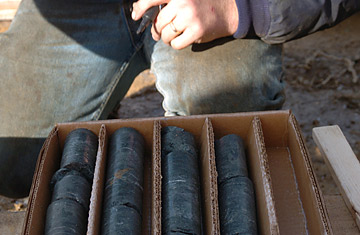
Boart Longyear employee Joey Davis prepares to label a box of the first uranium cores to come out of the ground in 25 years at Coles Hill, Va., in Pittsylvania County on Tuesday, Dec. 18, 2007.
Virginia's scenic, rolling Piedmont is rich in presidential history — Thomas Jefferson, James Madison and James Monroe all made their homes there. The land is also rich in uranium. But the state has had a moratorium on mining the nuclear fuel since 1982. Now, a group of landowners in rural Pittsylvania County is looking to make a fortune by digging up the ore, and, with talk of nuclear energy making a comeback following last summer's sky-high gas prices, the state is thinking about giving its blessing. The Virginia Commission on Coal and Energy is preparing to undertake a study on whether uranium can be extracted without contaminating the air or polluting the water.
The stakes are huge. The 30 or so landowners who formed Virginia Uranium Inc. say the two deposits they want to mine contain up to 120 million pounds of ore, enough to mine for decades. With uranium spot prices hovering around $47 a pound, the ore in Pittsylvania, never mind the rest of the state, is worth billions of dollars.
Only the moratorium stands in the way. The history of the ban begins in 1977, when the Marline Uranium Corp., a subsidiary of the Marline Oil Co., began looking for the ore around the state. (The U.S. Geological Survey has concluded that vast swaths of the Piedmont, between the low-lying Tidewater to the east and the Blue Ridge to the west, potentially hold uranium.) In two years Marline had found the monster deposits in Pittsylvania. The discovery touched off a hunt for uranium statewide, alarming communities along the eastern slopes of the Blue Ridge that didn't want to see horse pastures turned into mining pits. In 1982, the state acted to ease nerves by declaring the moratorium. Then the price of uranium tanked, dropping to $9 a pound at one point. Mining companies had little incentive to challenge the moratorium, so didn't.
Today, most Virginians seem unaware that the fate of the state's uranium mining moratorium is being discussed anew. The state coal and energy commission's study that might persuade the state's General Assembly to lift the moratorium could still take up to two years to complete. But already in rural Pittsylvania, which has one of the state's highest unemployment rates, debate is fierce. Supporters say new mining technology will allow miners to get the uranium safely, the mine would offer much-needed jobs to 300 people, and the uranium would fuel new reactors and help the nation kick its foreign oil habit. Opponents point out that almost all uranium mining in the United States occurs in arid, sparsely populated places out west that are geologically unlike anything in Virginia. In the water-rich Old Dominion, they argue, radioactive materials from uranium such as thorium-230, radium-226 and radon-222 could shake loose and leach into the groundwater. Meanwhile, the large piles of mining debris known as "tailings" could blow in the wind and contaminate the air. "It's going to rain down dust like lint," predicts 57-year-old cattle farmer and mine opponent Phillip Lovelace of Pittsylvania.
Virginia Beach and neighboring Chesapeake, two cities with a combined population greater than 600,000 that get part of their water from Pittsylvania streams, are alarmed at talk of lifting the moratorium. Virginia Beach opposes the mining plan outright, while Chesapeake has expressed grave concerns to state officials. Opponents are also skeptical of the job claims: in all the uranium mines out west, which produced 4.5 million pounds of uranium in 2007, there are fewer than 400 miners employed, according to statistics from the U.S. Energy Information Administration.
To settle the issue, the state commission hopes to enlist the help of the National Academy of Sciences to conduct the study. Meanwhile, opponents have organized and circulated petitions and enlisted the help of environmental groups, including the Southern Environmental Law Center in Charlottesville. Virginia Uranium for its part has agreed to merge with a Canadian mining company, Santoy Resources of British Columbia, to ensure it has the capital to press forward with its mining plans. In the end, insists Walter Coles, head of Virginia Uranium, there will be no mining if it puts the environment at risk. "If we're going to do it, it has to be done safely."
